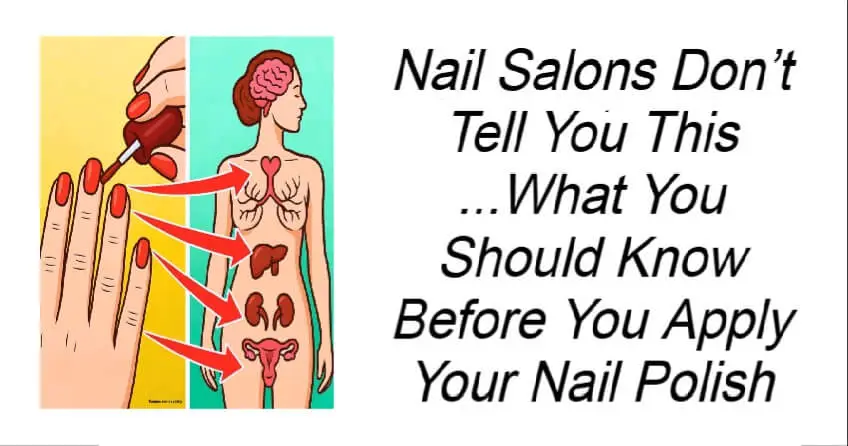Nail Salons Don’t Tell You This …What You Should Know Before You Apply Your Nail Polish
Nail polish is a go-to beauty essential for millions of people looking to express their style and add a pop of color to their look. But applying it is more than just brushing on a pretty hue—understanding how polish works, what’s in it, and how to apply it properly can make all the difference between a chipped mess and a salon-quality finish.
Whether you’re new to DIY manicures or a seasoned pro, this guide will walk you through everything you need to know about nail polish ingredients, safer alternatives, and tips for keeping your nails healthy and strong.
The Basics: What Is Nail Polish Made Of?
Nail polish is a complex mixture of ingredients formulated to deliver color, durability, shine, and smooth application. While many are considered safe in small doses, others may have health or environmental concerns—especially with long-term or frequent use.
Here’s what’s inside your nail polish bottle and what to watch out for.
Common Ingredients in Nail Polish
1. Film-Forming Agents
- Example: Nitrocellulose
- Function: Creates a hard, glossy coating after drying
- ✅ Safe but highly flammable in liquid form
2. Resins & Plasticizers
- Examples: Tosylamide/formaldehyde resin, camphor, TPHP (triphenyl phosphate)
- Function: Prevents cracking, boosts shine, and adds flexibility
- ⚠️ Some (like TPHP) are linked to hormonal disruption
3. Solvents
- Examples: Ethyl acetate, butyl acetate, isopropyl alcohol
- Function: Keeps polish fluid and helps it dry
- ⚠️ Can irritate eyes and lungs in poorly ventilated spaces
4. Colorants and Pigments
- Examples: Iron oxides, titanium dioxide, FD&C dyes
- Function: Adds color and special effects like shimmer
- ✅ Generally safe; just watch for non-biodegradable glitter
5. UV Stabilizers
- Example: Benzophenone-1
- Function: Prevents fading and discoloration
- ⚠️ Possible endocrine disruptor—moderate use is key
Ingredients to Avoid in Nail Polish
When shopping for nail polish, look out for these potentially harmful chemicals:
- Formaldehyde – A known carcinogen used in hardeners
- Toluene – Linked to headaches and nervous system effects
- Dibutyl Phthalate (DBP) – A reproductive toxin
- Formaldehyde Resin – Can cause allergic reactions
- Camphor – May trigger nausea or dizziness
- TPHP – Endocrine disruptor
- Parabens – Suspected hormone disruptors
- Xylene & Ethyl Tosylamide – Banned in some countries for toxicity
These are often referred to as the “Toxic Trio” (formaldehyde, toluene, DBP), though many clean brands now eliminate up to 10–12 problematic ingredients.
✅ Choosing Safer Nail Polish: What to Look For
Many modern formulas are labeled “X-Free,” where “X” stands for the number of harmful chemicals excluded:
- 5-Free: No formaldehyde, toluene, DBP, camphor, or formaldehyde resin
- 7-Free: Adds xylene and ethyl tosylamide to the banned list
- 10-Free or 12-Free: Also omits parabens, phthalates, fragrances, and animal-derived ingredients
Cleaner Alternatives:
- Plasticizers: Opt for acetyl tributyl citrate instead of DBP or TPHP
- Preservatives: Look for phenoxyethanol instead of parabens
- Glitter: Choose biodegradable or natural shimmer
- Colorants: Mineral-based pigments and ethically sourced mica
Top 5 Risks of Using Nail Polish
- Chemical Exposure – Regular use of toxic formulas can cause allergies or respiratory issues.
- Nail Damage – Overuse and harsh removers can weaken nails.
- Staining – Especially from dark shades, if you skip a base coat.
- Infections – Improper removal or application may damage nail beds.
- Environmental Harm – Disposing of polish and remover irresponsibly contributes to pollution.
Application Tips for a Flawless, Healthy Manicure
Even the best formula won’t work without the right technique. Follow these tips for salon-worthy results:
- Start clean: Remove old polish and wash hands thoroughly
- Use a base coat: Prevent staining and extend wear
- Apply in thin layers: Two coats are usually enough
- Seal with top coat: Adds shine and protection
- Dry thoroughly: Avoid smudging by giving your nails enough time to cure
- Moisturize regularly: Use cuticle oil and hand cream to prevent dryness
Beautiful Nails, Better Choices
Nail polish is more than a beauty product—it’s a chemistry lesson in a bottle. By understanding the ingredients and making informed choices, you can protect your health and reduce your environmental impact.
Choose non-toxic, clean-label polishes whenever possible, take good care of your nails, and apply with attention to technique. Your hands (and the planet) will thank you.
You’ve just read, Nail Salons Don’t Tell You This . Why not read Husbands Tries To Get Clever With His Wife

